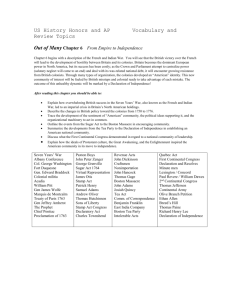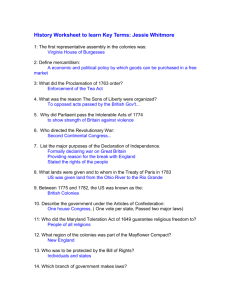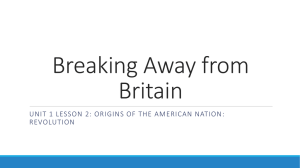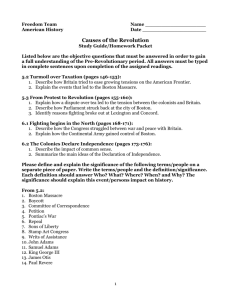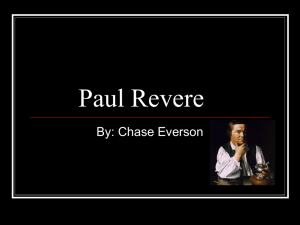The American Revolution
advertisement
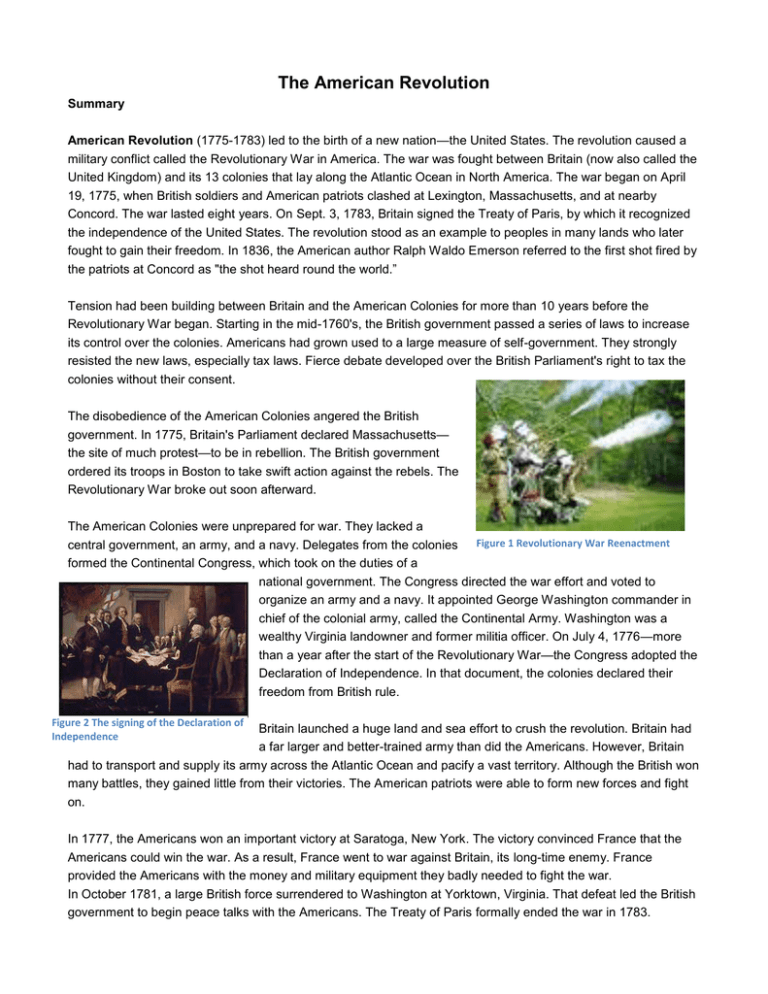
The American Revolution Summary American Revolution (1775-1783) led to the birth of a new nation—the United States. The revolution caused a military conflict called the Revolutionary War in America. The war was fought between Britain (now also called the United Kingdom) and its 13 colonies that lay along the Atlantic Ocean in North America. The war began on April 19, 1775, when British soldiers and American patriots clashed at Lexington, Massachusetts, and at nearby Concord. The war lasted eight years. On Sept. 3, 1783, Britain signed the Treaty of Paris, by which it recognized the independence of the United States. The revolution stood as an example to peoples in many lands who later fought to gain their freedom. In 1836, the American author Ralph Waldo Emerson referred to the first shot fired by the patriots at Concord as "the shot heard round the world.” Tension had been building between Britain and the American Colonies for more than 10 years before the Revolutionary War began. Starting in the mid-1760's, the British government passed a series of laws to increase its control over the colonies. Americans had grown used to a large measure of self-government. They strongly resisted the new laws, especially tax laws. Fierce debate developed over the British Parliament's right to tax the colonies without their consent. The disobedience of the American Colonies angered the British government. In 1775, Britain's Parliament declared Massachusetts— the site of much protest—to be in rebellion. The British government ordered its troops in Boston to take swift action against the rebels. The Revolutionary War broke out soon afterward. The American Colonies were unprepared for war. They lacked a central government, an army, and a navy. Delegates from the colonies Figure 1 Revolutionary War Reenactment formed the Continental Congress, which took on the duties of a national government. The Congress directed the war effort and voted to organize an army and a navy. It appointed George Washington commander in chief of the colonial army, called the Continental Army. Washington was a wealthy Virginia landowner and former militia officer. On July 4, 1776—more than a year after the start of the Revolutionary War—the Congress adopted the Declaration of Independence. In that document, the colonies declared their freedom from British rule. Figure 2 The signing of the Declaration of Independence Britain launched a huge land and sea effort to crush the revolution. Britain had a far larger and better-trained army than did the Americans. However, Britain had to transport and supply its army across the Atlantic Ocean and pacify a vast territory. Although the British won many battles, they gained little from their victories. The American patriots were able to form new forces and fight on. In 1777, the Americans won an important victory at Saratoga, New York. The victory convinced France that the Americans could win the war. As a result, France went to war against Britain, its long-time enemy. France provided the Americans with the money and military equipment they badly needed to fight the war. In October 1781, a large British force surrendered to Washington at Yorktown, Virginia. That defeat led the British government to begin peace talks with the Americans. The Treaty of Paris formally ended the war in 1783. Timeline On March 5, 1770, a mob surrounds a British sentry outside the Boston Custom House. The soldier calls for help. Seven or eight soldiers arrive, but the crowd will not disperse. A shot is fired, and then more shots. Five colonists die, and six are wounded. The "Boston Massacre" becomes a rallying cry for those opposed to British rule. On Dec. 16, 1773, 50 colonists dressed as Mohawk Indians dump 45 tons of tea into Boston Harbor to protest the British tax on tea. This became known as the “Boston Tea Party.” On March 31, 1774, Britain's Parliament retaliates for the Boston Tea Party by passing the first of the "Intolerable Acts." The first act is to blockade Boston Harbor until the tax on the destroyed tea is paid. The First Continental Congress begins meeting in Philadelphia on Sept. 5, 1774. Every colony but Georgia is represented. Congress declares that the "Intolerable Acts" are not to be obeyed and supports the formation of local militias. Figure 3 Boston Tea Party On the night of April 18, 1775, Paul Revere and William Dawes ride out of Boston to warn local militias that British regulars are on the march to seize munitions and arrest rebel leaders in Concord, Mass. On April 19, redcoats and Colonists skirmish on Lexington Green and at a bridge in Concord. The Revolutionary War has begun. In June 1776, the Continental Congress, still in Philadelphia, begins work on a Declaration of Independence from Britain. On July 4, Congress adopts the Declaration. Delegates begin adding their signatures to the official copy in August. Figure 4 Paul Revere's Ride After a series of defeats in the fall, General Washington's troops retreat across the Delaware River to Pennsylvania. On Christmas Day, 1776, Washington and his men recross the Delaware. They surprise and quickly defeat British Hessian mercenaries. Figure 5 George Washington France, a United States ally since February, declares war on England on July 10, 1778. On Sept. 23, 1779, John Paul Jones fights the Royal Navy frigate Serapis off the British coast. Though Jones's ship is on fire and sinking, he refuses the British captain's demand to surrender. "I have not yet begun to fight," he replies. Three hours later, the Serapis surrenders to him. After a disastrous 1780, with defeats, near-mutiny, and Benedict Arnold's betrayal, the Continental Army's fortunes change. In the climactic battle of the war, French and American troops force the surrender of Lord Cornwallis's 9,000 soldiers at Yorktown, Pa., on Oct. 19, 1781. Peace talks begin in Paris in April 1782. Some fighting remains. The Treaty of Paris is signed in November. The US Congress declares the war over on April 11, 1783.
